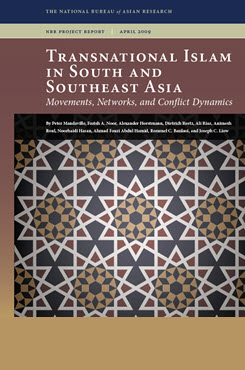From Transnational Islam in South and Southeast Asia: Movements, Networks, and Conflict Dynamics
Transnational Islam in India
Movements, Networks, and Conflict Dynamics
This paper argues that India’s Muslims have largely shunned Islamic violence and radical influences, though perceived marginalization and insecurity among this minority community could prove a potential source for radicalization.
EXECUTIVE SUMMARY
Since the events of 9/11, transnational Islamic forces have consolidated more along religious lines with regional and local Islamic outfits to further the extremist cause worldwide. South Asia has been confronting the challenge of Islamic extremism for many years and in varied forms. Among the South Asian countries worst hit by Islamic extremism, India, with a Muslim minority population numbering over 140 million, has cradled a number of important transnational Islamic movements throughout history. As this paper shows, many of these movements have tremendous influence on present-day Islamic radicalism and grassroots activism all over the world. This paper argues that India’s Muslims have largely shunned Islamic violence and radical influences, though perceived marginalization and insecurity among this minority community could prove a potential source for radicalization.
MAIN FINDINGS
While many Islamic movements arising from India remain local in influence, others have spread across the world, primarily through immigration and the Indian diaspora, missionary activities, and pilgrimages to Mecca. The roots of India’s Islamist challenge can be traced to late nineteenth century India where the seeds of dominant reformist and revivalist movements were implanted, namely: the Deoband, Tablighi Jamaat, Ahle Hadith and Jamaat-i-Islami. In due course, these movements have transcended the political boundaries of the subcontinent and manifested in both violent and pietistic forms at home and elsewhere. The key principle which drives India’s transnational Islamic movements (with the exception of Sufi mystic movements) is the establishment of the imaginary Ummah through either violent or other (e.g., conversion) means. Unlike other parts of the world where the transnational Islamic movements are intense, only a small section of India’s Muslims is believed to be endorsing radical Islam, though the numbers are increasing. While India’s Muslims have largely shunned Islamic terrorism, there is evidence of Indian Muslims contributing to international terrorism. Increasingly, Indian Muslim youth are talking about the plights of fellow Muslims in Afghanistan, Iraq, Chechnya, and neighboring Pakistan. Indian blogospheres and social networking websites are full of these instances. India’s leading radical Muslim youth movement and increasing source of concern is the Students Islamic Movement of India (SIMI).
POLICY IMPLICATIONS
- In India, the drive to implement shari’a has never been as intense as in Pakistan and Bangladesh. However, a sense of insecurity has long gripped India’s Muslims. Future policy should monitor and address this perception of marginalization.
- A small section of India’s Muslims—homegrown jihadists—has taken to terrorism and has acquired international links in recent times. Terrorism among Indian Muslims appears to have originated following the Babri mosque demolition in 1992. Since then, the potential for homegrown terrorism has grown extensively throughout the country.
- The changing Islamic political landscape in neighboring Bangladesh and Pakistan, where terrorist outfits have political parties with overt ties to transnational movements and networks, and the resurgent Islamic violence in the region will likely dictate the future trajectories of transnational Islam in India.


